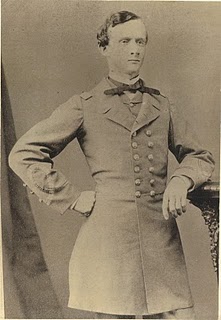WHITTLE-WILLIAM
WILLIAM CONWAY WHITTLE

UNK

SERVED IN U.S. AND CONFEDERATE NAVIES
William Conway Whittle was born on January 16, 1840, in Norfolk, Virginia, the son of a career U.S. and Confederate Navy officer. William graduated from the U.S. Naval Academy in 1858 and was first assigned to the USS ROANOKE. When Virginia seceded from the Union, William resigned from the U.S. Navy and was commissioned a Lieutenant in the Virginia Navy and later the Confederate States Navy. His first wartime assignment was the command of a naval battery at West Point on the York River, Virginia, during the Peninsula Campaign.
After a short period on the James River, Whittle was transferred to the CSS NASHVILLE as Third Lieutenant. He was aboard NASHVILLE when it made a cruise to England in November 1861 and a hazardous return voyage to Beaufort, North Carolina. Whittle was next sent to New Orleans, where as Third Lieutenant he boarded the ironclad CSS LOUISIANA which had been built to defend the lower Mississippi River. In April 1862, LOUISIANA found herself under attack as Union forces surged against Confederate forces near New Orleans. During the battle LOUISIANA was set afire and her crew scrambled ashore. When the flames reached her magazine she blew up and was destroyed. Whittle was taken prisoner by Union forces and sent to Fort Warren in Boston Harbor where he remained until exchanged in August 1862.
Upon return to the Confederacy, Whittle took command of the gunboat CSS CHATTAHOOCHEE with the rank of First Lieutenant. Whittle was later selected to run the blockade with important correspondence for the Confederate commissioners in Europe and to personally deliver dispatches to the Confederate officer in charge of purchasing and outfitting English built Confederate vessels which were being built as commence aiders. By the spring of 1864, Whittle had reached Paris where he awaited the company of other Confederate naval officers.
Historical records indicate Confederate naval agents were successful in purchasing a British military troop transport which was renamed the CSS SHENANDOAH and converted into a commerce raider. In October 1864, Whittle joined SHENANDOAH as Executive Officer and was aboard when the ship made an epic voyage to the distant reaches of the North Pacific in search of the American whaling fleet. SHENANDOAH captured and destroyed 29 vessels in the North Pacific during a twelve week span in the spring of 1865 not knowing that the war was over. In August 1865, confirming that the Confederacy had been defeated, SHENANDOAH, with a crew of mostly men from Scotland and England, set wail for England where the ship surrendered to the Royal Navy at Liverpool on November 6, 1865, becoming the only Confederate Navy ship to circumnavigate the world.
At the close of the Civil War, some Union officials looked upon SHENANDOAH crewmembers as pirates and wanted to prison them as such. Accordingly, Whittle remained in Europe for several months looking for work in various countries. When the possibility of a pardon was rejected and the most promising opportunity seemed to be in Argentina, Whittle and several other officers went there. The homeless Whittle remained in Argentina until 1876 when he finally returned to Virginia where he was appointed captain of the Bay Line in charge of coastal steamers on the Baltimore-Norfolk-Portsmouth route. He held this position until 1890 when he became superintendent of floating equipment on the Norfolk & Western Railroad until the fleet was sold in 1901. In 1902, Whittle and several partners organized the Virginia Bank and Trust Company in which he served as Vice-President and Director. He died on January 5, 1920, and was buried at Cedar Grove Cemetery in Norfolk,, Virginia.
Submitted by CDR Roy A. Mosteller, USNR (Ret)

